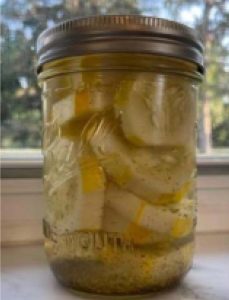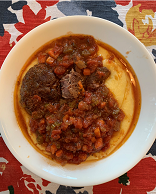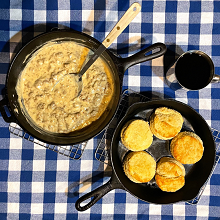I will admit it. I am not really one to “celebrate” all these new week-labels we’ve added to our calendars. But I do like food and food statistics. When I heard about “Food Check-Out Week” I knew I had to learn more.
Food Check-Out Week is the time in the new year when the average American has earned enough to pay for their whole year’s groceries. It is celebrated the third week of February. This approximately marks the percentage of time we have worked to earn enough income to pay for our groceries for the year. That is between 5 and 7 weeks of the year if you’re counting. Five out of 52 weeks, just to pay for our food.
I celebrated “Food Check-Out Week” last month in a conversation with my husband about a recent grocery bill. He claimed it was too high. I threw these and some other statistics on the table. Not for dinner, but just for fun.
Percentage of America’s Income Spent on Food
The average American household spends 11.3% of their “disposable” income on food. Define “disposable” because I can’t afford to throw any away. However, of all the countries in the world, the average American’s yearly food bill is the lowest percentage relative to their income. 2015 statistics compared the percentages between the most developed nations of the world – the United States (lowest percentage), Singapore, United Kingdom, Switzerland, Cananda, Ireland, Australia, and Austria, respectively. Worldwide, Nigeria has the highest percentage of their income spent on food. Looking at it this way, more developed nations have more food resources available for lower prices because of our highly developed food systems. Of course, this does not take into account how many people in poorer nations may be foraging for or growing the majority of their food. These are interesting statistics, and not ones which Americans usually think about. Most of us just think food has gotten much more expensive.
More United States Food & Income Statistics
- It takes most Americans 100 days of work to pay their income taxes (27% of our income)
- An average American is 3 generations removed from the farm
- $0.079 is the farmer’s share of what you pay for groceries per dollar
- 44% of the average American’s food purchases are for home food consumption while 56% of the average American’s food purchases are spent eating out
- S. food prices rose by 25% from 2019 to 2023 (USDA Economic Research Service link)
“If you ate today, thank a farmer”

And what better way to say, “thank you” to the farmers who provide our nourishment than to meet them face to face at our local Farmer’s Market? While you’re there, buy some of what they have worked so hard to grow. Tell them how you are going to prepare it, with whom you will share that meal, and maybe exchange some recipes.
We are fortunate here in Indian River County to have a couple of Farmer’s Markets to choose from. Additionally, many of our area farmers have their own road-side outlet in which they sell their produce. Peterson’s Groves, White Rabbit Acres Organic Farm, Jackson’s 8th Street Farm, and Five Acre Farm, just to name a few. There is the Farmer’s Market on Melody Lane in Downtown Ft. Pierce. And in Vero Beach, we have the Saturday morning Oceanside Farmer’s Market which operates from November through May, from 8 AM until noon. So, grab your large reusable bags, some cash, and go shop local this Saturday. You can find directions and recipes on the Vero Beach Farmers Market website.
Two of our local producers, Birdie Hogan Farm and Fojtik Flatwoods Farm, graciously provided some of their own family recipes for us to share with you. Birdie Hogan Farm is a fourth-generation family-run farm producing vegetables and grass-fed, grass-finished beef. At Fojtik Flatwoods Farm, you’ll find three generations of Fojtiks raising chickens and hogs. You can find both Birdie Hogan and Fojtik Flatwoods Farm at the Vero Beach Farmers Market.

“Quickles” – Quick Dill Pickles
Contributed by Elizabeth Fojtik
Ingredients:
8-10 Birdie Hogan yellow Cucumbers
4 cups water
2 cups white vinegar
2 tablespoons salt
1-2 sprigs fresh dill OR 1 tablespoon dried dill
Optional: Garlic cloves, peppercorns, red pepper flakes
Preparation:
- Wash and cut cucumbers into ¼-inch slices.
- Make the brine by combining the water, vinegar, salt, and spices (if using) in a saucepan. Bring to a boil and make sure the salt has dissolved. Remove from the heat and let cool. Stir in the dill.
- Add cucumber to jars, do not pack super tight as you want the brine to cover all surfaces of the cucumber slices. Pour in enough brine in to cover all the cucumbers.
- Seal with a lid and allow to come to room temperature before storing in the refrigerator.
- Wait 2-3 days before enjoying. Pickles should be good in the refrigerator for 4 weeks or more.
Osso Bucco- with Birdie Hogan beef shanks Serves 2+ people

Contributed by Elizabeth Fojtik
Ingredients:
2 Birdie Hogan Osso Bucco (beef shanks)
¼ cup all-purpose flour
Salt & Pepper to taste
3 tablespoons olive oil
1 cup onions, diced
¾ cup carrots, diced
¾ cup celery, diced
¾ cup dry white wine
1 ½ cups stewed tomatoes
Zest of one lemon
1 teaspoon anchovy paste
Fresh thyme & oregano (or dried)
Prepared risotto, polenta, or mashed potatoes
Preparation:
- Place the flour on a plate and season with salt and pepper. Coat the shanks with the flour mixture.
- Place 2 tablespoons of the olive oil in a heavy frying pan. Heat the oil, place the beef shanks into the heated, oiled pan and brown them on all sides over medium high heat. This could also be done in an 8” to 10” Dutch oven with a tight-fitting lid.
- Once the meat is browned, transfer it to a plate and set aside.
- Using the same pan, add the remaining 1 tablespoon olive oil and saute´ the onions, carrots and celery until tender (10-15 minutes).
- Deglaze the pan with the white wine and add the stewed tomatoes, lemon zest, anchovy paste, salt, pepper, and herbs. Stir to combine.
- Add the beef shanks back to the pan with all the vegetables, making sure the shanks are covered by the liquid.
- Bring mixture to a boil, reduce heat to simmer and cover. Cook on your stovetop with the lid on for 2-4 hours, until the meat is almost falling off the bone. The time varies based on your heat level and pot. Check every 30 minutes until the meat is falling off the bone.
- Once the meat is tender, serve with the sauce over risotto, polenta, or mashed potatoes.

“Sausage Gravy & Biscuits” – Serves 2 to 4 people, Preparation time: 25 minutes
Contributed by Elizabeth Fojtik
Biscuit Ingredients:
2 cups all-purpose flour
2 teaspoons sugar
3 teaspoons baking powder
1 teaspoon salt
½ cup butter or lard
½ to ¾ cup whole milk
Gravy Ingredients:
1 pound Fojtik Flatwood Farm Breakfast Sausage
3 tablespoons butter
3 tablespoons all-purpose flour
3 + cups whole milk
Dash of salt, pepper, garlic powder to taste
Preparation:
- preheat oven to 450° F
- Prepare biscuit dough. Mix together the flour, sugar, baking powder and salt. Grate super-cold butter into shavings, then gently fold it into the dry mixture. Stir in milk, a little at a time. This dough should be shaggy and sticky.
- On a lightly floured surface, knead the dough no more than 5 times. Pat dough into a 1-inch thick disk, fold in half, pat down gently again, and fold in half one more time (helps insure biscuits have layers). Gently pat dough to 1-inch thick and cut with a floured round 2-inch cutter or a drinking glass.
- Place side by side on a cast iron skillet, or an un-greased cookie sheet. After cutting as many biscuits as possible, lightly press the scraps back together and cut remaining biscuits.
- Bake for 10-12 minutes, or until golden brown. (For extra goodness, brush with melted butter immediately after removing from the oven)
- While the biscuits are baking, brown the sausage over medium-high heat in a cast iron or heavy bottom skillet. When fully cooked and no longer red, remove sausage from pan with slotted spoon, leaving fat in the pan.
- Reduce the heat to medium-low and melt the butter. Sprinkle in the 3 tablespoons flour, whisking to prevent lumps. Allow this roux to cook for 3-5 minutes, whisking often, until light to medium brown.
- Stir in milk, a little at a time, whisking heavily. Allow gravy to simmer to cook for about 5 to 8 minutes, until desired thickness is achieved. You can always whisk in more milk if it’s too thick.
- Stir the cooked sausage back into the gravy in the pan and cook for another few minutes. Season to taste with salt and pepper.
- Serve immediately over warm biscuits.
Working in UF/IFAS Extension, we are all about food and agriculture. It’s right there in our name: University of Florida’s Institute of Food & Agricultural Sciences Extension. Focusing on the agricultural portion of our food statistics, on average, our farmers share of that percentage is only 7.9 cents per dollar we spend on our food. Just some food for thought and an incentive to go shop your local farmer’s market this weekend.
Further Research-based Reading
Sticking with our topic of food and farmer’s markets, the University of Florida’s Institute of Food and Agricultural Sciences Electronic Data Information Source (UF/IFAS EDIS) has several publications for your further reading, including,
“Consuming Local Vegetables from Our Local Growers“
“Best Practices for shoppers at the Farmer’s Market”
“Florida Vegetable Gardening Guide” is a must have resource for anyone who wants to grow their own healthy vegetables. It has been proven that gardening is beneficial to our health. What better way to improve your lifestyle than by vegetable gardening.
“Costs and Benefits of Vegetable Gardening” publication may be the UF/IFAS EDIS publication for you if you’d like to really calculate the costs and weigh the benefits of growing your own food. This publication has handy printable spreadsheets for drilling down those calculations.
There are some hard-to-find “minor vegetables” out there. Some of these may be unknown to many of us but a few do show up at the farmer’s markets from time to time. “EDIS topic page of MINOR VEGETABLES” is a list of publications, one for each of the more common minor vegetables.
by Yvonne Florian
Source: UF/IFAS Pest Alert
Note: All images and contents are the property of UF/IFAS.



